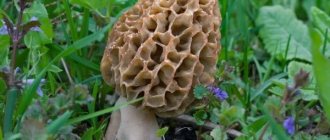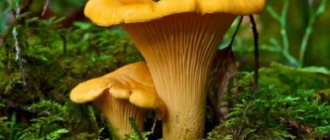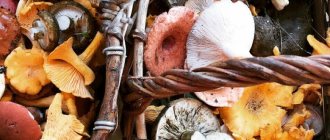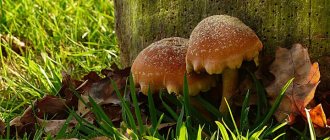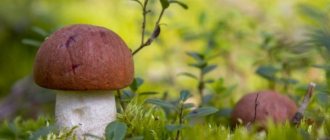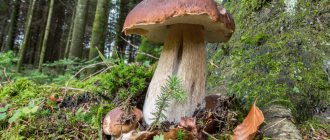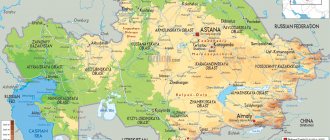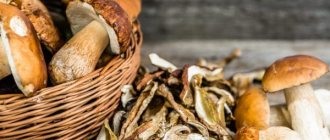Mushrooms of the Moscow region have a distinctive species diversity. In the forest surroundings you can collect a lot of useful mushrooms, in particular, porcini mushrooms, popular for their distinctive taste. Experienced mushroom pickers in the Moscow region have a lot of places where you can find a large number of edible mushrooms. However, inexperienced mushroom pickers should be very vigilant so as not to accidentally put a poisonous mushroom in the basket, the consequences of consuming which can be extremely dangerous. The main types of edible and dangerous mushrooms are presented below.
Are there mushrooms in the Moscow region in 2022 and what kind?
The summer of 2022 is warm and rainy, so mushrooms in the Moscow region began to grow earlier than usual. Folk omens do not work due to unpredictable weather, and it is this that determines the mushroom harvest. It has been noticed that if the weather is calm and not abnormal, it is constantly hot or rainy, then there are few mushrooms. If it gets very cold, mushrooms will soon appear. The end of May 2022 was unusually cold, so mushrooms began to be collected in the forests of the Moscow region in mid-June. Mostly white ones, chanterelles, and boletuses are found.
Mushrooms in the Moscow region always come 2 weeks after a sharp cold snap. After 3 weeks there are as many of them as possible, and then the yield decreases. Throughout July you can safely collect chanterelles, and in the second half of the month - white chanterelles with aspen mushrooms, russula with boletus mushrooms, and champignons. Later – summer mushrooms.
Mushroom places in the Moscow region, how to get there by car on the map?
The modern world is developing every year, allowing people to travel by private car to any corner of their country. It is not surprising that for many years many mushroom pickers have preferred a car to public transport, and a GPS navigator to a compass. Now you can get to the desired collection point by entering the coordinates in your smartphone or car panel.
Important!
The mistake of many mushroom pickers is to search for prey at the beginning of the forest. If you want to reap a good harvest, it’s better to get to the place correctly and take a walk several kilometers deep. This approach will increase the chances, making a quiet hunt productive, capable of producing fruit not only for food, but also for harvesting for the winter.
Naming the exact deposit is sometimes difficult even for an experienced mushroom picker. Local residents who go searching every year always remember successful gathering places, but they cannot always find the prey if a year or two has passed. This phenomenon is explained by a period of rest that occurs every other year. The second option for the absence of mushrooms is incorrect collection. Beginners often pull out mushrooms with part of the mycelium, reducing fruiting and reducing it to a minimum.
Healthy!
Often, directions for a trip to pick mushrooms can be determined by tips on the forum or VK groups. The messages will tell the person interested which location will be the most promising.
Before going to the forest, in addition to plotting the route on the map, you should carefully consider the chosen place. The duration of the forest zone will allow you to determine for sure where the most mushrooms may be, and in which direction it is better to take a walk.
Important!
You can improve your performance by going to the forest on weekdays. Competition from Monday to Friday is reduced by almost 75%, allowing quiet hunters to collect enough mushrooms for pickling and cooking.
What mushrooms grow and where in the Moscow region
Map of mushroom places in the Moscow region:
- in the north
- chanterelles;
- Russula;
- white;
- boletus;
- Champignon;
- in the West
- white;
- bluelegs;
- summer honey mushrooms;
- in the east
- boletus;
- gray-yellow tinder fungi;
- chanterelles;
- boletus;
- on South
- White mushrooms;
- boletus;
- honey mushrooms;
- boletus.
How to get to the forest best: minibus or metro
You can get to the right place in different ways, depending on your desire and the distance of the trip. Local residents can stay by train or bus, and if they have extra money, take a taxi.
By printing or specifying a location on a mushroom map, the navigator will help you get exactly to the desired area. The most important thing is not to get lost and get out of the thicket before it gets dark. Traveling early in the morning will speed up the process, allowing the quiet hunt to be completed before lunch.
Mushrooms that should not be picked
Forests bear fruit not only with edible mushrooms, but also with some that are dangerous to human health. In the Moscow region you can find spring entoloma . This is a mushroom with a cone-shaped, hump-shaped or wide-conical cap, the surface of which is silky and slightly sticky, and the stem is grayish-brown or black.
The second dangerous mushroom in the Moscow region is the sulfur-yellow false honey fungus . It has sulfur-yellow or greenish-olive plates that smell unpleasant.
It is necessary to avoid winter urnula. It has an ovoid shape, which over time becomes cupped and brown in color.
Also in the Moscow region you cannot collect:
- toadstool;
- fly agaric;
- cobweb.
It is also prohibited to collect species listed in the Red Book - leotia gelatinosa, sheep polypore, chestnut polypore, for example.
Rules for picking mushrooms in the Moscow region
In the Moscow region, mushrooms are found in mixed and coniferous forests, near birch, oak, aspen, spruce, and pine trees. Also on the edges, near paths. There are many of them within 50 km of the capital. In addition, mushrooms grow there, which cannot be poisoned. Everyone knows that edible species become dangerous because they accumulate heavy metals. For the same reason, mushrooms are not picked near busy roads.
Single mushrooms are a rare phenomenon: they grow in groups. It is better to collect them early in the morning. Mushroom pickers recommend wearing comfortable clothes and shoes, covering your legs and arms, and wearing a hat.
Mushroom season is in full swing. White boletuses and boletus mushrooms are sold briskly at the markets. Young blackheads, boletus and boletus have grown up. There’s nothing even to say about russula and chanterelles - they’re everywhere. We publish maps of mushroom places in the Moscow region*
Kazan direction
Gzhel station. 4 - 5 km north of the railway, in the vicinity of the villages of Minino and Konyashino.
Grigoryevo station.
Ingatyevo station.
Kuzyaevo station. On both sides of the railway.
Shevlyagino station. North of the platform 2 km towards the villages of Averkovo and Shabanovo.
Platform 73rd km, Antsiferovo, station. Boletuses. 3 - 4 km from the railway.
Ryazan direction
Bronnitsy station . 5 - 6 km from the villages of Biserovo, Plaskinino.
Platform 63 km. 3 - 4 km from the railway.
Faustovo station. 3 - 4 km from the railway.
Peski station. 5 - 6 km near the villages of Berdniki and Novoselki.
Konev Boy station . In the direction of the villages of Shelukhino and Klimovka.
Shchurovo station. Near the village of the same name there is a coniferous forest. Chanterelles and porcini mushrooms.
Chernaya station. Located among a light pine forest. This is a cult place for mushroom pickers near Moscow. Even at the entrance to the station you can see them wandering among the tall trunks. When you exit the station, you almost immediately find yourself in the forest. Among the pines you can look for boletus and chanterelles. Pig mushrooms also love coniferous forests, but it is not recommended to collect them: these mushrooms absorb harmful substances very quickly. Either take them young, or discard them altogether.
Lukhovitsy station. Not far from the station there are two forested areas. The one to the north attracts with porcini mushrooms and boletus mushrooms. The locals call it that way: birch forest. After walking a couple of kilometers along a country road towards Moscow, you will come to an unusually beautiful pond. It is located on the edge of the forest, which is replete with boletus and aspen mushrooms.
Yaroslavl direction
Pravda station. 1 - 2 km from the railway on both sides. To the east - towards the village of Nazarovo. To the west - towards the village of Stepankovo.
Mushroom places, Yaroslavl direction
Pushkino station. This is one of the most environmentally friendly areas of the Moscow region. There are a lot of forests in the city area. Local grannies assure that there are mushrooms there. It all depends on your desire and perseverance. Lots of chanterelles and russula.
Sokolovskaya station. By bus number 349 from the station. From the Shchelkovskaya metro station you reach the final station (Shchelkovo-7), then you can catch a car and drive in a south-west direction. You disembark and walk through the forest in the same direction. From Yaroslavsky station by train to Fryazevo or Monino to Sokolovskaya. Next, take a bus or minibus to the village of Krasnoznamensky, then walk about 2 - 2.5 km north to the Klyazma River. It takes 40 minutes to get to Sokolovskaya by train.
Zelenogradskaya station. 2 km west of the platform in the direction of the village of Daryino.
Sofrino station. 3 - 4 km west of the platform in the direction of the villages of Mitropolye and Novovoronino.
Ashukinskaya station. Cross the rails and move into the thick of the forest. According to locals, there are a lot of boletuses here. You won't return with empty baskets. You can take a break on the banks of the Vyaz River. The water is clean, so you can swim. 4 - 5 km west of the railway in the direction of the villages of Novovoronino and Martyankovo.
Kalistovo station. 3 - 4 km west of the platform, in the forests near the village of Artemovo. To the east - towards the village of Golygino and along the banks of the Vori River.
Abramtsevo station. 4 - 5 km west of the platform near the villages of Zhuchki and Akhtyrka.
Semkhoz station. On both sides of the railway. To the south - towards the villages of Vysokovo, Morozovo, to the west - towards the village of Shapilovo.
Station 76 km. This is the longest mushroom hunting trip. We walk the first 5 km to the Yaroslavl highway at a brisk pace, admiring nature, but don’t forget to look under the Christmas trees. Red boletus caps await you here. Go out to the shore of Lake Torbeevskoye. You can swim, have lunch, ride a jet ski or rent a catamaran. There are restaurants, cafes, and kebab shops. You can spend the night in a hotel complex on the shore. From the shore you move north parallel to the Yaroslavl highway. Five kilometers to the highest waterfall in the Moscow region - Gremyachey. There are a lot of mushrooms in this area.
The village of Sharapovo. Locals call this place “the rows.” Porcini mushrooms are hiding under the moss in the swamp. If you arrive in early August, you will be greeted by a wild raspberry harvest. How to get there: from Yaroslavsky station to Sergiev Posad, then by bus to Sharapovo to the “Cemetery” stop. You go down to the lake and go around it on the left to the forest area.
The most mushroom route: from the platform 43 km to the west there are deciduous forests. You can move along the highway or forest paths to the village of Mitropole. Then you go from there along the banks of the Vyaz River, which will lead to the village of Eldigino. Next, the route will lead southeast to the village of Daryino. And from here the forest road, after about 3 km, will lead to the Zelenogradskaya platform. The length of the route is about 16 km.
Leningrad direction
Podrezkovo station. 1.5 km south of the railway line along the right bank of the Skhodnya River in the direction of the villages of Ivanovskoye and Korostovo.
Firsanovka station. There are mushrooms on both sides of the railroad. In the north - 1.5 km from the station towards the villages of Novye Rzhavki, Nazaryevo and further towards the village of Klushino. In the west - 3 km from the station across the Goretovka River towards the village of Ruzino and near Pyatnitskoye Highway.
Beryozki Dachnye station. 1 - 2 km from the railway on both sides. From the west - towards the village of Snopovo and to the banks of the Istrinsky reservoir. On the eastern side - on the territory of the former Verkhne-Klyazminsky Nature Reserve towards the village of Terehovo.
Golovkovo station. 1.5 km north of the station in the direction of the village of Ermakovo.
Pokrovka station. On both sides of the station. From the north side - towards the villages of Koskovo, Dulepovo, Shakhmatovo. On the south side - to the villages of Zamyatino and Nikulino.
Frolovskoye station. 2 - 3 km from the railway on both sides. East of the station - in the direction of the villages of Dulepovo and Golenishchevo. To the west - towards the villages of Marfino and Vvedenskoye.
Mushroom places, Leningrad direction
The most mushroom route: northeast from Firsanovka station to the village of Nazaryevo. Further - again to the northeast. Near the village of Elino, the route will cross the Leningradskoye Highway and lead into a dense mixed forest. This is the land of boletus mushrooms, porcini mushrooms, saffron milk caps and honey mushrooms. The trail leads to the banks of the Klyazma to the village of Poyarkovo.
Savelovskoe direction
Lobnya station. 3 km east of the railway line in the direction of the Pyalovsky reservoir.
Lugovaya station. Mushrooms can be found on both sides of the railway: in the west, 2 km towards the village of Ozeretskoye. To the east of the station - 3 km towards the villages of Sholokhovo, Fedoskino, as well as along the banks of the Pyalovsky reservoir. In these places you can collect a good harvest of chanterelles, boletus and boletus.
Mushroom places, Savelovskoe direction
Lugovaya station. Mushrooms can be found on both sides of the railway: in the west, 2 km towards the village of Ozeretskoye. To the east of the station - 3 km towards the villages of Sholokhovo, Fedoskino, as well as along the banks of the Pyalovsky reservoir. In these places you can collect a good harvest of chanterelles, boletus and boletus. From Savelovsky railway station to Lugovoy station it takes 40 minutes. You can get there by any train, except the next one to Orudevo station.
Nekrasovskaya station. A kilometer west from the platform towards the village of Ozeretskoye. From Moscow to Nekrasovka it takes 42 minutes.
Catuar station. 2 km west of the station.
Trudovaya station. In a southwest direction.
Iksha station. There are mushrooms 2 km west of the station in the direction of the villages of Staro-Podgornoye, Khoroshilovo, Lupanovo. Boletus and boletus are found in these places. From Khoroshilov to the northeast to the Morozki platform. From Savelovsky station to Iksha - 54 minutes by train.
Morozki station. There are mushrooms on both sides of the railway: 1.5 km in the west - near the villages of Novlyanka, Grigorkovo, 2 km in the east - near the villages of Sboevo, Grishino, Novinki. Travel time from the station is 1 hour.
Tourist station. Mushrooms can be found on both sides of the railway: to the west - 4 km towards the villages of Dyakovo, Paramonovo, Strekovo. 2 km in the east - towards the villages of Shustino and Ulyanki. From Moscow to Tourist it takes 1 hour and 7 minutes.
Vlasovo station. A kilometer west of the station towards the villages of Bobylino and Popadyino. 1.5 km on the north side of the railway in the direction of the villages of Rastovtsy, Sorokino. It takes 2 hours to get to Vlasovo station. You can get there by train going to Taldom or Savelov.
Taldom station. 4 km southwest towards the villages of Nagovitsino and Gusenki. There are a lot of chanterelles in these places. From Savelovsky station to Taldom - 2 hours 10 minutes.
The most mushroom route: from Iksha station, go towards the village of Khoroshilovo (about 2 km). From here you need to turn northeast to the Morozki platform. The length of the route is about 15 km.
Riga direction
Opalikha station. In the north of Opalikha station in the direction of the village of Saburovo and in the forests along the banks of the Nakhabinka, Banka and Sinichka rivers, in the south towards the villages of Nikolo-Uryupino and Voronki there is a forest rich in mushrooms. To get to these places you need to walk 2 - 3 km, since there is no transport from the railway station. You can't drive a car there either. The train to Opalikha takes about 35 minutes.
Nakhabino station. According to locals, there are mushrooms 4 km north of the station towards Kozino along the banks of the Nakhabinka River. The drive to Moscow is about 45 minutes.
The village of Pavlovskaya Sloboda. The surroundings of this village are rich in mushrooms, in particular champignons. From the railway station From Nakhabino to Pavlovskaya Sloboda there is minibus No. 23, the ride to the village is about 10 minutes. There are lakes near Pavlovskaya Sloboda and the village of Valednikovo, where you can swim. Both in Nakhabino and Pavlovskaya Sloboda they sell mushrooms, mainly champignons.
Dedovsk station. 3 - 4 km from the station to the north from the railway line towards Turov and Nikolo-Cherkizovo.
Snegiri station. On both sides of the railway. In the north - 2 km from the station towards Eremeev, in the south - a kilometer towards the village of Zhevnevo and along the right bank of the Istra River.
Kholshcheviki station. A kilometer south of the station and further in the forests along the right bank of the Malaya Istra River.
Yadroshino station. On both sides of the railway. In the north - a kilometer from the station towards the village of Markovo-Kursakovo. In the south - behind the Volokolamsk highway, 3 km from the station, in the direction of the villages of Lapino and Novodarino.
Kursakovskaya station. To the east from the station towards the village of Markovo-Kursakovo.
Rumyantsevo station. 2 - 3 km from the railway line on both sides. In the eastern and northern directions - towards the villages of Rybushki, Savelyevo, Dolevo, along the banks of the Maglushi River. In a south-west direction - towards Lake Trostenskoye.
Lesodolgorukovo station. To the north of the railway line towards the villages of Nudol-Sharino and Maryino.
Mushroom places, Riga direction
The most mushroom route: 2 km north of Opalikha station, behind the village of Novonikolskoye, on the banks of the Banka River. The forest here extends for several kilometers to the west and east. Go around the village of Saburovo from the west and head towards the village of Fedorovka. From the village of Yurlovo on Pyatnitskoye Highway you can take a bus back to Moscow. The length of the route is 12 km.
Belarusian direction
Zhavoronki station. 1 km south of the station, in the direction of the villages of Mitkino, Sumino, Malye Vyazemy. 2 - 3 km north of the railway line towards the village of Nazaryevo, in the vicinity of which you can now “hunt” for chanterelles and honey mushrooms, as well as in the forest along the banks of the Bolshaya and Malaya Vyazemka rivers. From Belorussky Station to Zhavoronki it takes about 50 minutes by train.
Khlyupino station (Zvenigorodskaya line from Golitsyno station) . From the southwest the forest came close to the railway line. Route in the direction of the villages of Raevo and Alyaukhovo. To the north and northeast of the station you can go through the forest to the villages of Chigasovo and Goryshkino. There are also mushrooms in the village of Malye Vyazemy. Malye Vyazemy station is one stop on the train, before reaching Golitsyn.
Mushroom places, Belarusian direction
In the Smolensk direction Golitsyno is the largest city. Various mushrooms are sold at the market near the station. If you decide to spend the weekend in the Moscow region, you can spend the night in Golitsyn: there is a small hotel in the former House of the Writers' Union (single and double rooms). The rooms are not luxurious, but there is a shower and toilet. To get to the hotel, you need to turn left from the platform and walk about 700 meters in a straight line. The low red brick building on the right is the hotel.
Skorotovo station (Zvenigorod line) . To the north from the station in the direction of the village of Dunino, to the east - towards Chigasov, to the south and southwest - to the villages of Raevo and Alyaukhovo.
Zvenigorod station. In the western and eastern directions from the station in the vicinity of the villages of Maryino, Salkovo, Dunino. In the west - near the villages of Klopovo, Pestovo, as well as along the banks of the Ostrovnya River. There is a minibus going to Zvenigorod from Golitsyno station.
Stations Sushkinskaya, Petelino, Chastsovskaya and Portnovskaya (the stations follow each other). 2 - 3 km from the stations, a huge forest stretches in a southern direction for many kilometers, to the Kyiv direction railway.
Petelino station. In the northern direction there is a forest rich in mushrooms (north is the right side of the railway tracks when coming from Moscow). At the station Petelino there is a sign to the Petelino poultry farm. If you follow this road, you can come to places rich in mushrooms, a lot of honey mushrooms. From Moscow to Petelin it takes about an hour.
The most mushroom route: from Petelino station you walk along the Ostrovni River to the north, passing the village of Tatarki, the village of Gar-Pokrovskoye and the village of Ivonino. Then walk about 6 kilometers along a forest path along the bank of the Ostrovni River to the village of Pestovo. From here head north-east through the forests to the village of Klopovo. 2 km east of it is the Zvenigorod station.
Kiev direction
Here, in the vast deciduous and mixed forests, mushrooms of all kinds grow
Pobeda station. Mushrooms on both sides of the railway (1 km). In the southeast - towards the village of Kalugino. In the west - to the villages of Sumino, Sanniki, Mamyri. It is better to get there from the Kievsky railway station on all trains, except those going to the Airport, Solnechny and Lesnoy Gorodok. It takes 48 minutes to get to Pobeda station.
Dachnaya station. 2 km south of the platform in the forest beyond the Desna River, in the vicinity of the villages of Svitino and Timonino. Travel time from Moscow is 55 minutes.
Selyatino station. Move south and southeast from the station in directions to the villages of Syryevo, Glagolevo, Ignatovo. From Kievsky railway station to Selyatino station - approximately 1 hour 3 minutes by train.
Rassudovo station. 2 - 3 km east of the railway line in the direction to the village of Glagolevo, as well as in the vicinity of the villages of Kuznetsovo, Dolgtino, Ignatovo.
Ozhigovo station. A path goes south from the platform, which after 1.5 km intersects with the Kyiv highway. Then the path goes through fields. Head south. It's easy to get lost here, so you need to take a compass. After crossing the Ladyrka River, you will find yourself in a forest - Kuznetsovskoe forestry. You can return to Moscow from the Bekasovo or Zosimova Pustyn platforms, which are located to the west. There are quite a lot of russula and nigella in these places. From Moscow to Ozhigov it takes 1 hour and 10 minutes.
Mushroom places, Kiev direction
Bekasovo station. Mushrooms on both sides of the railway in the area of 1 - 2 km. Head east and south from the station, in these places the forests are very rich in mushrooms, especially in the area of the villages of Ivanovka, Afanasovka, Savelovka and Mogutovo. From Kievsky station to Bekasov it takes 1 hour 12 minutes only by train, going to Maloyaroslavets.
Bashkino station. Forests on the west side of the railway. 2 km east of the station towards the village of Pokrovka. The forests are rich in russula and other mushrooms. Bashkin can be reached in 1 hour 47 minutes.
Obninskoye station. North-west of the station, 2 - 3 km towards the villages of Samsonovo, Belkino, as well as on both banks of the Protva River.
The most mushroom route: a path goes south from the Ozhigovo platform. After 1.5 km it crosses Kievskoye Highway. Then the path goes through fields. In the west you can see the village of Sotnikovo. From here it is better to move in a southerly direction. You cross the Ladyrka River and find yourself in the Kuznetsovskoye forestry, thinned out by unusual clearings. They start at the forester's house and spread out in twenty-five rays in all directions. You can return to Moscow from the Bekasovo platform. The length of the route is 12 - 15 km.
Kursk direction
Here there is an abundance of russula, nigella, milk mushrooms, boletus, aspen, chanterelles, and boletus.
Grivno station. 2 - 3 km east of the railway in the direction of the villages of Berezhki and Kharitonovo.
Lvovskaya station. To the southeast of the station in the direction of the village of Ivino.
Kolkhoznaya station. 2 - 3 km from the railway on both sides. In the east - towards the village of Nikonovo and in the forests along the banks of the Rozhaya River. South-east of the station in the forest behind the village of Sharapovo. In the west - towards the villages of Panino and Zhokhovo.
Station Chepelevo and Chekhov. In the direction of the villages of Alachkovo, Maksimikha, Oksino.
Luch station. 4 - 5 km from the railway on the western side in the vicinity of the villages of Popovka and Milyachino.
Sharapova hunting station. To the east to the villages of Pleshkino, Voskresenki, Petrukhino.
Avangard station. 2 - 3 km east of the station, in the direction of the village of Vskhody, as well as into the forests stretching along the banks of the Rechma and Lopasnya rivers. You can get to the Lopasni River valley from Serpukhov by bus to the village of Gurovo or by boat to the Priluki pier.
The most mushroom route: start collecting 2 km east of Lvovskaya station in the forest behind the village of Lagovsky. In this forest, along the gentle slopes of ravines, in open birch forests, along the edges and old forest roads and clearings, whites grow. From the village of Meshcherskoye to Kolkhoznaya station you can walk along the picturesque banks of the Rozhaya River or straight through the forest. The length of the route is 16 - 20 km.
Gorky direction
Fryazevo station. South of the station beyond the village of Vselodovo.
Kazanskoe station. On both sides of the railway.
Paveletskaya direction
Vzletnaya station. On both sides of the station: in the birch forest behind the village of Redkino or west of the villages of Bityagovo and Yusupovo, as well as east of the station towards the village of Elgazin.
Vostryakovo station. 2 - 3 km from the railway, south of Zaborye.
White Pillars station. 3 - 4 km from the station in the direction of the villages of Shebantsevo, Kolychevo, Sonino, Kurganye.
Mushroom places, Paveletsk direction
Barybino station. West of the station behind the village of Rastunov, in the vicinity of Yusupov, Shishkin, Uvarov. Along the banks of the Severka River.
Velyaminovo station. 2 - 3 km from the railway on both sides. In the east towards the villages of Tatarinovo, Lenkovo, Kaverino and in the forests along the right bank of the Vostets River. In the west - in the vicinity of the village of Velyaminovo.
Privalovo station. 2 - 3 km from the railway on both sides. In the east - towards the villages of Konstantinovskoye and Kishkino. In the west - in the vicinity of Nemtsov, Sidorov.
Mikhnevo station. 3 km from the railway on both sides. To the east - towards Koshelevka, Vasilievsky, Ignatiev. To the west - to Razinkov and Usady.
Shugarovo station. 3 - 4 km west of the station, towards Torbeev, Zavorykin.
Zhilevo station. On both sides of the railway. In the east - 1 - 2 km towards the village of Petrovo, in the west - 3 - 4 km towards Pochinki, Sitna-Shchelkovo, Psarev.
Stupino station. 2 - 3 km from the railway on both sides. In the northeast - towards the village of Staraya Sitnya. In the west - to Matveikov, Saigatov.
Akri station. In the forest to the west and south of the station in the direction of Saigatov, Sokolovaya Hermitage.
The most mushroom route: start the hike from Belye Stolby station. A deciduous forest begins 1 km to the west. 6 km from the station, south of the village of Shebantsevo, you need to cross the Kashirskoe highway and go deeper into the forest south of the village of Sonino. This is the kingdom of porcini mushrooms. From Shebantsev you can return along the road to the station. White pillars or take a bus to the station. Domodedovo or Mikhnevo.
*Maps are compiled based on information from mushroom picker forums and personal blogs of Internet users.
Graphics by Alexey Stefanov
Related topics:
- Mushroom picker map of the Moscow region
- Komsomolskaya Pravda published a map of mushroom places...
- Mushroom picker map of the Leningrad region
- Kazan: mushroom picker map
- Mushroom picker calendar for the Moscow region and central Russia
- Mushroom picker map of Prikamye
- Mushroom picker map of the Leningrad region. Sosnovo
- Kazan: mushroom picker map
Go back to main page
